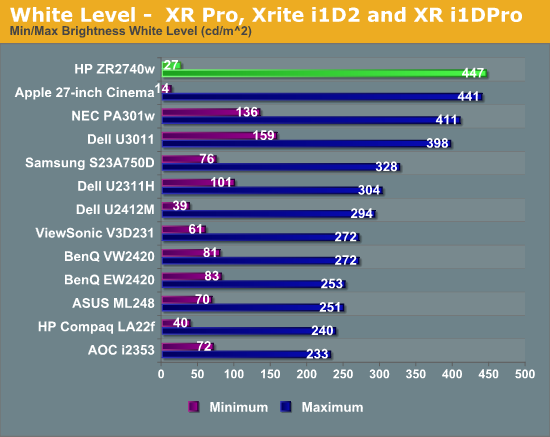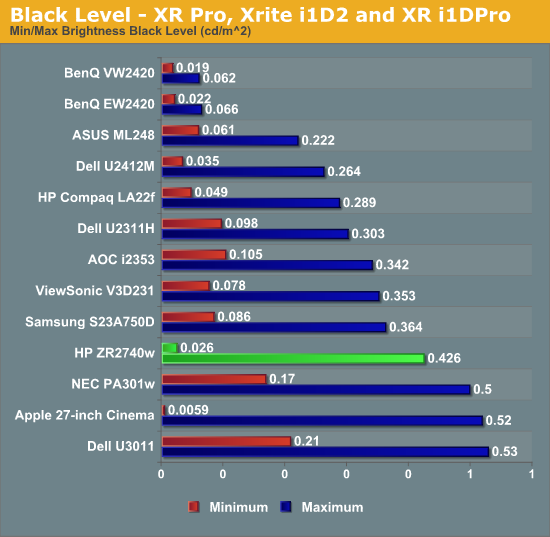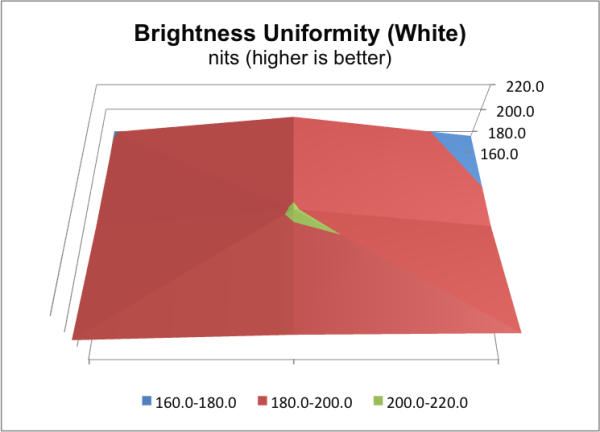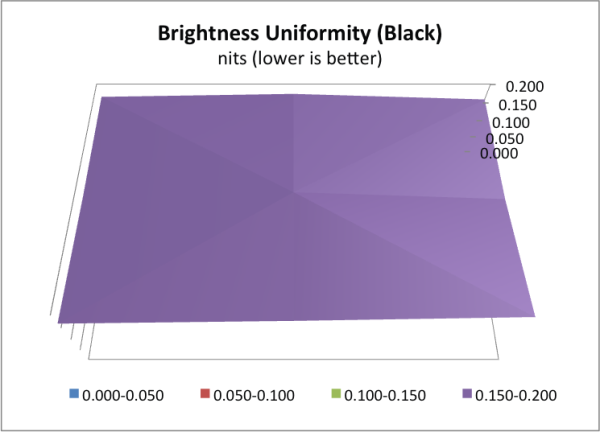HP ZR2740w - High Resolution IPS that Doesn't Break the Bank
by Chris Heinonen on March 16, 2012 1:15 AM ESTBrightness and Contrast
Is your work environment bright? Are there massive spotlights behind you that shine directly onto your screen? Well, don’t worry; the ZR2740w will produce more than enough light for you. I’d expect screens to get a little dimmer as the size gets larger, since a backlight would need to be more powerful and more expensive to light it up, but apparently that is not the case. The HP managed to put out almost 450 nits of brightness when turned up all the way, which is plenty for anyone no matter what their work environment.

I can only assume that to evenly light up a 27” or larger LCD panel, vendors need to use larger, more powerful backlights and it is as easy to use one that does this much brightness as one that only does 250 nits of light, but I’m going to say this is a good thing. The downside to a larger light is that it might cause the black levels to be higher than on other displays, and that does seem to be the case here with the HP.

The black levels on the HP are higher, but they are right in line with other 27” and 30” displays, so it really is a middle of the road result for it. Given the cost difference between the displays, that the HP equals them in performance is very nice to see on here. One area that the larger panels fell behind in was contrast ratio, where they only manage around 750:1 which is a little disappointing given their cost. The HP manages to exceed this, offering over 1,000:1 at both maximum and minimum brightness levels.

The only high resolution display we have tested that can exceed this is the Apple Cinema Display, but it only does that at peak brightness as the contrast ratio falls off at lower light levels. The more consistent results from the HP gives it the best contrast of any high resolution display currently tested in my mind. Of course a larger panel also means a higher chance of uniformity issues, so hopefully the powerful backlight is able to correct for that.
There is certainly a bright spot in the center of the screen and fall-off around the edges, but the variance comes in at a very respectable 4.67%, which outperforms many smaller panels. The black uniformity also comes in very well, with just 6.6% variance. Of course I’d expect the black level to perform better since the higher black level in general will lead to a smaller variance percentage, even if the amount of variance is higher. To account for that, I’ll start to report the percentage for the white uniformity, since that target is always 200 nits, and the actual variance for the black level, in this case 0.011 nits, as we target the minimum level for black. I wish the units were the same so it was easier to compare, but to do that we would have to have a black level target, which would hurt displays that can do a lower level of black than others.












119 Comments
View All Comments
Snowshredder102 - Friday, March 16, 2012 - link
These monitors have been floating around the $700 price range for some time now. Not a fan of a 16:9 monitor for that price, this monitor also has terrible response time for anyone that plays any games. I don't see anything really special about this.JarredWalton - Friday, March 16, 2012 - link
Please define "terrible", because in my experience less than a frame of lag is nothing. I have an older S-PVA (Dell 2408WFP) with about three frames of lag. My personal threshold is around 20ms before it starts getting bad, relative to an S-IPS 30" display. Based on Chris' measurements I would guess I could get away with ~35ms delay relative to a CRT.As for your comment in regards to price, you're smoking something:
http://www.newegg.com/Product/ProductList.aspx?Sub...
$600 27" LCDs have been around for a long time, but they were all 1920x1080 or maybe 1920x1200. If you can provide links to any other 2560x1440 27" displays with IPS panels that cost less than $700, let's see them. I can't recall ever seeing anything like that for this price, outside of the HP ZR2740w.
Snowshredder102 - Friday, March 16, 2012 - link
I've heard people claim that an input lag above 10 starts getting bad. As for the price you're looking at FULL retail. I've seen these monitors for sale on a number of places. My U3011 has an MSRP of $1500, I bought it for $1150 on sale and during that time the u2711 was at $750. I've seen brand new HP 2560x1440 IPS monitors for $650. Sales come by decently often, you just have to put some effort in scoping out deals.JarredWalton - Friday, March 16, 2012 - link
A periodic sale is one thing, a normal price is another. The ZR2740w might go on periodic sales for under $550 given the current MSRP. It's good to see the base price well under $1000 for one of these displays for a change.esse09 - Friday, March 16, 2012 - link
Hello Jarred,the U2711 retails for the same price as the ZR2740w.
Based on your own reviews i'd say you should suggest picking the Dell monitor instead of this one as far as bang for the buck is concerned. What do you think?
JarredWalton - Friday, March 16, 2012 - link
It depends what you're after, really. The U2711 currently goes for more like $830+ based on what I can find:http://configure.us.dell.com/dellstore/config.aspx...
http://www.amazon.com/dp/B0039648BO
That's a full $200 more than what we can find the ZR2740w selling for, and it's not all sunshine and roses for the U2711. It has excellent colors, more connectivity options... and more input lag/processing lag. Tom's Hardware measured lag at 98ms (http://www.tomshardware.com/reviews/ultrasharp-u27... but I measured it at just 16-18ms (http://www.anandtech.com/show/2922/4). I'm not sure which is "right", so I'll leave that to you.
If you don't need the extra inputs or high color gamut, and you'd prefer to save $200, I'd take the HP. If you can get the Dell on sale for $630, however, I'd probably go that route.
Mitch89 - Sunday, March 18, 2012 - link
I'm a big fan of the U2711, I've used two of them on a video editing suite I built and they are gorgeous. They are AU$899 here in Australia, and despite the fact they cost more here than the US (despite our dollar being higher...) they are easily worth the money.Ramiliez - Friday, March 16, 2012 - link
Magical number for 60Hz panels is 16,7 msCommon monitor refresh rate is 60Hz that means every 16,7 ms image is refreshed therefore response time (crystal color change + input lag) below 16,7 ms is useless
For 120Hz panels the magic number is 8,3 ms
mathew7 - Friday, March 16, 2012 - link
Please don't confuse refresh rate and input lag.Input lag means the time for a pixel on the wire to be shown on screen. If a monitor waits for a whole image before refreshing it's panel, then yes, you will have 16ms input lag. But this will be for the top-left pixel. The bottom-right will be less, as the panel refresh nowadays is much faster than accepted refresh rate.
And 0 input+processing lag is desireable for any fast-paced action. It's not useless, it's ideal. And don't forget also the rendering time.
PS: your comparison is like saying that if your car's top speed is 100mph, then there is not reason for you to drive more than 100 miles.
imaheadcase - Friday, March 16, 2012 - link
Input lag is only as bad as the person who uses the monitor notices.I have a U2410 24inch and don't notice a difference in gaming with it vs a 120hz monitor.